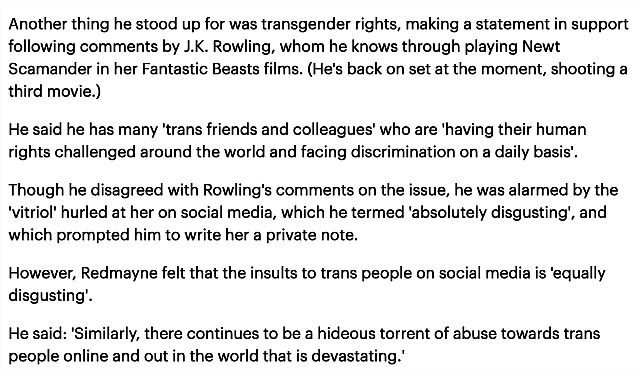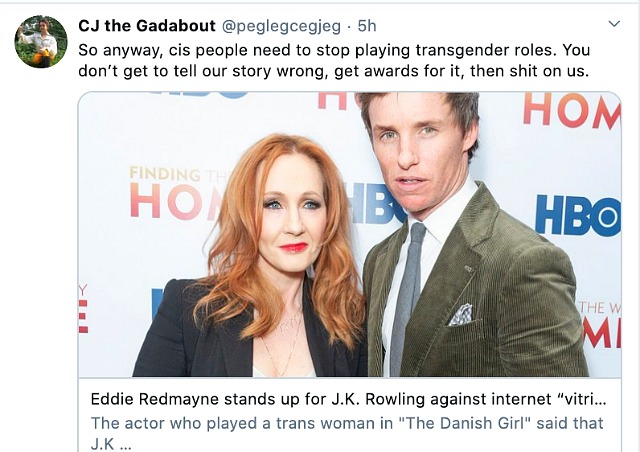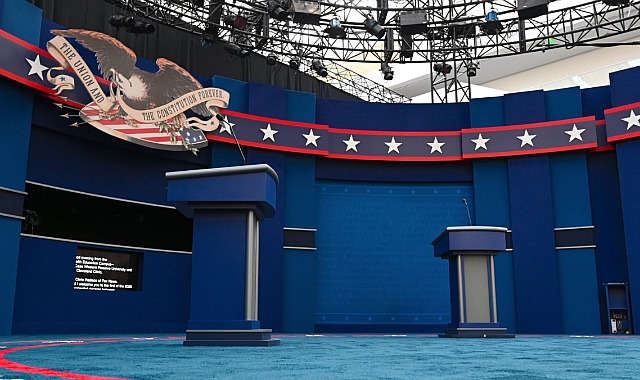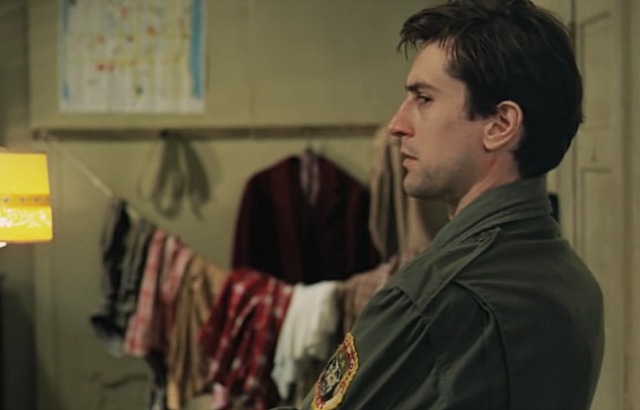Seven and a half months ago a Russian guy named Alexander Britvin posted a newly colorized version of Fritz Lang‘s Metropolis. Except it’s not so much “colorized” as gently tinted with pastel watercolors, principally with shades of golden sepia amber. Nothing is crudely or garishly painted. I found the effort captivating. I’ve seen Metropolis three or four times, but I watched at least half of Britvin’s version last night and early this morning. I truly believe that if Lang could somehow return to terra firma and see this version, he would at least respect what Britvin tried to do.
 Jeffrey Wells
Jeffrey Wells
HE Confession + Spiritual Cleansing
This is going to sound a bit strange, but late last night I experienced what felt like a kind of epiphany — a sense of myself and especially my hardnosed style of writing that that I’m suddenly not happy with on a certain level, and an idea that henceforth I need to dial that down. I’m not talking about abandoning my voice but chilling it down some.
After last night’s debate I was reading over some of my old stuff, and the strangest thing happened. I was suddenly stepping outside myself and reading the material like a 30something critic from England, and I was saying to myself, “This guy pushes too hard and uses too many adjectives. I could make him sound better by turning the current down and easing up on the pugilism.”
The combination of listening to Donald Trump bark and goad like a junkyard dog and then (this is going to sound really strange) watching Mervyn LeRoy‘s The FBI Story (’59), a total Eisenhower-era propaganda film that is nonetheless about basic middle-class decency and serving something greater than yourself…the combination of these influences seemed to open a door within, and all of a sudden I was saying “I have to stay as far away from caustic Trump vibes as possible, and I need to inject a little Jimmy Stewart into my soul.”
I know, I know…I’ll never be Jimmy Stewart or Tom Hanks either. I’m a sober, cat-loving Chris Walken from Connecticut by way of Next Stop, Greenwich Village, The Dogs of War, At Close Range and The King of New York. But I just knew last night that I needed more Stewart and less barking in my life.
The daily HE grind is a bear. It’s tough to push out four or five riffs or rants or reviews in exactly the right way. Sometimes a column piece won’t really read right until I’ve edited it over a 12-hour or even a 24-hour period, and then even then it sometimes feels a bit off.
I only know that I need to calm things down and not push quite so hard. I learned the value of “less is more” back in the ’70s, but I need to re-apply it. A voice is telling me this, or more precisely a whisper. Which is how inspiration always makes itself known.
To echo that great South African critic and cinematic seer Guy Lodge, “What a brand!”
Over the last 22 years Hollywood Elsewhere (including the early expressions on Mr. Showbiz, Reel.com and MoviePoopShoot) has gone through four phases.
First was the frank, occasionally tart, sometimes bludgeony attitude that began with the October ’98 launch of Mr. Showbiz, and which ended in April ’06 when I junked the twice-weekly column posting with “The Word” (short items) and shifted into a daily bloggy-blog format.
HE output increased greatly after that, and built up steam between ’06 and ’12 — a somewhat more gushy, stream-of-consciousness tone began to take over, and with that a certain…well, brashness-and-buckshot approach from time to time. Not always but now and then.
Phase Three began to take hold when I embraced sobriety on 3.20.12. The effects of a dry lifestyle are always gradual and drip-drip-drip (and sometimes one step forward and two steps back), but the wild and woolly era of ’06 to ’12 began to downshift in…I don’t know, ’13 or thereabouts. Certainly by early ’14.
Phase Four began in early ’18 when the wokester Robespierres began to seize the reins and go after transgressors, and despite the fact that my sins have never been about anything other than being overly mouthy and intemperate within the confines of the column, things became to get increasingly combative and punitive. A consensus began to take hold that I was some kind of obstinate shitheel and that I needed to dial it down and eat a little humble pie. More and more the title of this column became Hollywood Elsewhere: Under Siege.
Wrestlemania
“Biden on that stage calling the president of the United States a clown and a liar is not something Biden would have done four years ago under any circumstances. That he felt he [had] to do it is a sign to outsiders that American culture is in a cycle of decline.” — Jeremy Shapiro, research director of the European Council on Foreign Relations, to N.Y. Times reporter Steven Erlanger.
“Who won and who lost? I know I’m supposed to make something of a determination along those lines, but that’s not how this debate went down. Trump talked more and faster and louder, which was clearly his strategy: Be so damned vivid that Biden would look even paler than usual.
“In this Trump was successful. He had more fire — but dangerously, even dementedly, so. He never wore Biden down, but at moments he wore Biden out: Listening to Biden’s sentences peter out could be like hearing the air seep from a tire.
“But here’s the deal, as Biden would say: Only one man on that stage persuasively communicated that he has the interests of the American people at heart. Only one man on that stage seemed at all interested in maintaining a tether to the truth. Only one man demonstrated any respect for [Chris] Wallace or for the process. Only one man would be bearable for the next four years.
“I needn’t spell out who that man is.” — from Frank Bruni‘s “After That Fiasco, Biden Should Refuse to Debate Trump Again,” posted on 9.30.


“…It’ll Do Until The Mess Gets Here”
Donald Trump had no interest in observing any sort of moderation or decorum during Tuesday night’s debate. Because he deliberately ignored the usual way that Presidential candidates behave in these events, the debate was mainly about bullying, street-fighting, “so’s your old man” and tough-guy jawing. Not just with opponent Joe Biden but also moderator Chris Wallace, who struggled without much success to exert a semblance of control.
So with a brawl going on and Trump obviously refusing to back off, it fell to Biden to do two things — not let Trump elbow him aside with macho taunts, and at the same time try and appeal to the adults in the room with sane, sensible messaging.
I was amazed that the debate was unruly as it was, but I have to admit that I loved it when Joe snarled back. I went “yes!” and punched the air when he called Trump “this clown” and told him to “shush” and “shut up, man.” I also loved “you’re the worst President America’s ever had.”
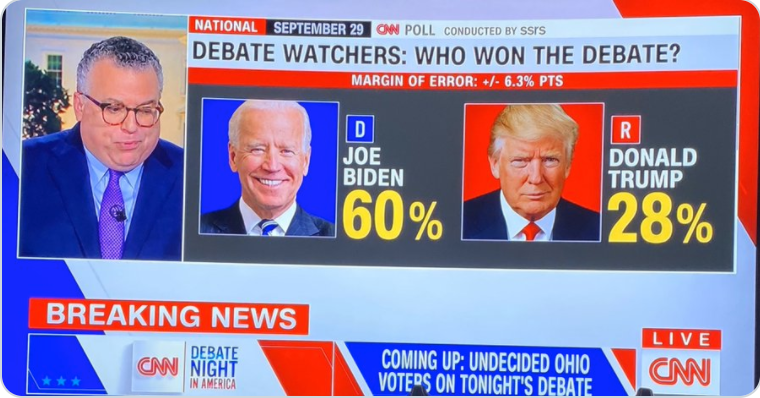
In short Joe was the calmer and more centered of the two. He was coming from a solemn, steady place. But if he hadn’t lashed out at Trump he would’ve seemed too old, too frail. (At least to some of the guys out there.) So I’m glad he punched back a few times.
To go by recent N.Y. Times reporting Trump flat-out lied when he said he paid “millions and millions” in taxes in 2016 and ’17.
Some apparently enjoyed the street-corner aspects of the debate. I heard from a friend who felt that Joe was “too soft” and obliging. Pugnacious, rude-ass Trump unfortunately set the tone. Wallace tried to rein him in but without much success.
Trump’s “Proud Boys” remark — “Stand back and stand by” — will sound hooliganish to the left and the centrists, but ugly, pot-bellied, T-shirt-wearing righties will love it. Because “stand by” was a rallying cry, as in “I’m with you, guys…keep your powder dry and the time will come.”
Wallace: “Mr. President, I am the moderator of this debate, and I would like you to let me ask my question and then you can answer it…let [Biden] answer!”
Trump reply (at one point): “I guess I’m debating you, not him, but that’s okay, I’m not surprised.”
Wallace at halfway point: “The country would be better served if we allowed both people to speak with fewer interruptions, and I’m appealing to you, sir, to do [that].”
Trump: “And him, too?”
Wallace: “Well, frankly, you’ve been doing more interrupting.”
Ghost Cafe
Le Pain Quotidien’s main website informs that certain locations in Los Angeles and New York City have re-opened. Alas, their Melrose Ave. location in West Hollywood, which I live close to, has been abandoned. And over the last two or three months it’s become a homeless hangout. Which means garbage strewn around, folded cardboard “beds” on the porch, homeless guys talking to themselves or arguing with each other, an occasional empty shopping cart, a vague aroma of excrement. A once lovely and lively cafe with great salads, breads, soups, brunch dishes, excellent coffee and a nice clientele…as recently as last February it was a great place with a nourishing vibe, a little touch of France in West Hollywood, and now it’s a flophouse for miserable, unwashed souls…a community center killed by the pandemic. And a damn shame.


Debate Clock Is Ticking
It’s absolutely certain that Donald Trump will constantly lie and fabricate during tonight’s Cleveland debate with Joe Biden. Yes, Biden will have many opportunities to call Trump on his whoppers, but do I understand that absolutely no clarifying information will be offered to viewers as Trump goes into his usual b.s.?
Debate moderator Chris Wallace has told N.Y. Times reporter Michael Grynbuam that fact-checking will be “a step too far” and that he doesn’t want to be “a truth squad“, and that it’ll basically be up to Biden to challenge Trump on this and that. Biden will therefore have to spend a good deal of his camera time shaking his head and saying that Trump is confused, a chronic liar or a dishonest sociopath, or a combination of all three.
Barely 100 people will attend in person. Each candidate has two minutes to respond to a question. No opening statements. The first question will be asked of Trump.
NPR’s Domenico Montanaro: “Debates can go very far south when a moderator isn’t in control. How and how much will he fact-check both candidates, Trump in particular, given that he can be so combative and is fine with running with things that aren’t true? How will Trump respond to Wallace pushing back?”
University of Pennsylvania historian Mary Frances Berry to NPR’s Domenico Montanaro: “The people who just want to get rid of Trump will be satisfied if Biden shows up, if he doesn’t collapse in the middle of the debate, and whatever he says, even if it’s erroneous or a gaffe — like 200 million [who have died from the coronavirus] — they’ll dismiss that, and people will just give him a pass.”
It’s now 3:30 pm Pacific. The Biden-Trump debate begins at 6 pm or 9 pm Cleveland time.
Don’t Blame Jenkins For Accepting Paycheck Gig
None of us should begrudge Barry Jenkins for accepting a lucrative paycheck gig to direct a CG Lion King sequel. Like anyone else he needs a certain level of income to keep body and soul together, and there’s nothing wrong with cashing in on his reputation as an indie-level dispenser of vision, integrity and cinematic persuasion. We all need to sell out once in a while.
What Jenkins is doing is roughly analagous to Stanley Kubrick accepting a director-for-hire gig on Spartacus. That 1960 slave-revolt epic wasn’t Kubrick’s “own”, but he did a better-than-decent job with it and in so doing upped his industry cred, which allowed him to direct Lolita, Dr. Strangelove and so on.
Deadline, Variety and others reported earlier today that Jenkins will direct a Lion King sequel.
Jenkins will therefore be obliged to reiterate the basic idea behind the original, which is that the African wildlands are a kind of monarchy-styled, talking-animal neverland, and that all animal species (including those who are routinely killed and eaten by lions) are beholden to the “king” in the same way that the British used to be invested in the lore of the Royal family.
Zebras, wildebeests, buffalos, antelopes, gazelles and other grazing animals: “We admire your courage, Simba, and especially the way you fought to reclaim your throne from Scar. You are the King of the Pride Lands. All we ask in return is that if you happen to spot one of us in a field somewhere…uhm, we don’t know to put this exactly but if you happen to encounter one of your grazing subjects, perhaps you’ll give some thought to not tackling them, clamping your teeth over their windpipe and tearing their stomachs open so you can gorge on their intestines?
“We know this sounds ridiculous, but on the other hand…well, just think about it. We recognize your power and regality, King Simba, and we will always bow our heads respectfully when you walk by, but at the same time we hate the idea of being murdered and eaten. Yes, we know how this sounds. Please forgive us for not volunteering to be killed. How about this…if you happen to tackle one of us, could you please make sure that we quickly die from windpipe suffocation rather than agonizing disembowelment?”
Jenkins on the Lion King gig: “Helping my sister raise two young boys during the ’90s, I grew up with these characters. Having the opportunity to work with Disney on expanding this magnificent tale of friendship, love and legacy while furthering my work chronicling the lives and souls of folk within the African diaspora is a dream come true.”
Variety‘s Rebecca Rubin and Brent Lang have reported that the forthcoming sequel, which will be scripted by Jeff Nathanson (author of the screenplay for Jon Favreau‘s 2019 Lion King feature), may be a prequel to some extent.
Rubin/Lang: “Sources say the new movie will partly focus on the early years of Mufasa, the regal father of Simba whose death forms the emotional heart of the first film and its remake.”
Nerves Are Killing Me
Yesterday a doomsaying friend again predicted a Trump victory “because the left has lost its mind. I don’t want a close election — I want a blowout. But what reasonable people who aren’t in the [liberal] bubble would look at the wokester fanatics on the left right now and say, ‘Yeah, I want those people in charge?'”
Lefty Twitter terrorists will not be “in charge” if Biden wins. They will seek to influence, of course. They will naturally persist in their militancy, as well they should because, apart from the fact that most many of them would like to bring career death and ruination to left-of-center types who have their own minds, many if not most of their views are fundamentally humanist.
The bottom line is that Amiable Joe is not beholden to them. He’s a 20th Century guy — a decent, respectful, soft-spoken, left-leaning centrist. Obviously far from God’s gift to progressives but a potential national blessing compared to the Trump malignancy.
As another friend said in response to the doomsayer, “Don’t you consider it at least possible that there are many, many people out there who — just like us — despise the woke left, are fully conscious of its disgusting trust-fund fascism, but hate Trump ten times more?”
“That’s the whole reason Biden was nominated: because he’s a liberal-centrist. I do not believe that people think he represents the woke left. I realize that you think people think he does, and that’s the disagreement.”
A close vote would drain the blood from my face. The apparent fact that Trump has retained the allegiance of slightly more than 40% of registered voters is horrifying in itself. But the numbers are not indicating a cliffhanger of any kind. I for one regard this 9.29 N.Y. Times poll as relatively trustworhty.
That just-released Washington Post-ABC News poll that has Joe Biden with a nine-point lead over Donald Trump in Pennsylvania? It’s based on polling between 9.21 and 9.26, and was therefore unaffected the 9.27 N.Y. Times report on Trump’s taxes and his $750 payment for 2016 and ’17.
A 9.28 Paul Krugman quote from “Trump’s Debt, His Future and Ours“: “How much will the revelation that he has always been a fraud hurt him? Many of his supporters will probably refuse to acknowledge the truth, perhaps because they won’t admit to themselves how completely they were scammed. But assuming that the news will have no effect at all is probably too cynical. And remember, Trump is running behind Biden, so he has to do more than keep his base — and this may not do much to win over undecided voters.”
Pete Was Way In Front
As Democrats and fair-minded Constitutionalists agonize over the forthcoming confirmation of Amy Coney Barrett and the resulting 6-3 conservative majority, it’s worth recalling that Mayor Pete was addressing the fundamental misrepresentation of American voter opinion early on.
From the time he announced his presidential candidacy on 4.14.19, Buttigeg was talking about expanding the number of justices from nine to 15, with five affiliated with Democrats, five affiliated with Republicans, and five apolitical justices chosen by the first 10.
No other candidate “made a Supreme Court overhaul central to his or her rationale for running and proposed presidential agenda,” according to NBC’s Josh Lederman. “Buttigieg has said structural democratic reform would be his top priority, vowing to launch a commission on depoliticizing the Supreme Court on his first day as president.”
Are You Speakin’ To Me?
As part of a week-long tribute to the recently departed Michael Chapman, Trailers From Hell is highlighting three brief Chapman commentaries, including Rod Lurie‘s 2013 riff on Martin Scorsese‘s Taxi Driver (’76).
Chapman’s impressionistic lensing of this moody portrait of increasingly delusional loneliness, and how a certain Manhattan cab driver is gradually engulfed by a vaguely hellish and spooky city with all kinds of needles and provocations…we all know the drill. But I have two quibbles with Lurie’s patter.
One, Taxi Driver is not “as depressing as a dying nun.” It’s hauntingly alive and pulsing and tingling with dread. “Depressing” is when a film depicts a relatively flat and oppressively defined realm of regimentation and submission from which there’s no escape.** “Depressing” is when a stuck, not-very-smart character is without nerve or options. Robert De Niro‘s Travis Bickle, one senses early on, is definitely a guy with options. They just happen to be of a powder-keg variety.
Two, Lurie suggests that Bickle’s “are you talkin’ to me?” is a steal from Shane — a line that Alan Ladd said to Ben Johnson inside Grafton’s Saloon and General Store. The line was actually “are you speakin’ to me?“, a slightly more refined form of inquiry. Plus it was ad-libbed by De Niro, and I seriously doubt if George Stevens’ 1953 western…aahh, who knows?
The difference between “talking” and “speaking” was pointed out in a scene from David Mamet‘s Glengarry Glen Ross:
Aaronow: Yes. I mean, are you actually talking about this or are we just…?
Moss: No, we’re just…
Aaronow: We’re just “talking” about it.
Moss: We’re just speaking about it. (Pause.) As an idea.
Aaronow: As an idea.
Moss: Yes.
Aaronow: We’re not actually talking about it.
Moss: No.
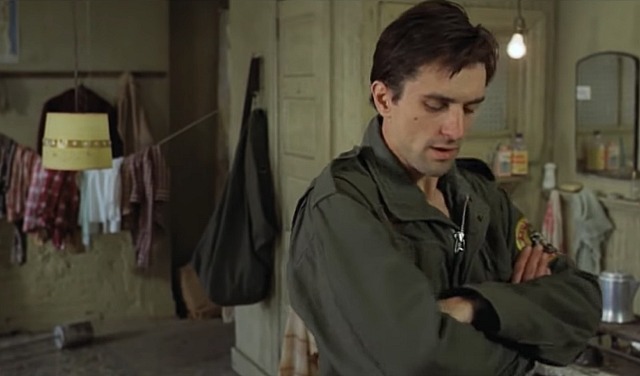
** Michael Radford‘s Nineteen Eighty-Four.
Redmayne Steps In it
Nearly four months ago J.K. Rowling landed in hot water when she said the wrong thing about transgender folk. She stated that “if sex isn’t real, the lived reality of women globally is erased…I know and love trans people, but erasing the concept of sex removes the ability of many to meaningfully discuss their lives.” The blowback was harsh; her remarks were derided as transphobic.
Now Transgender Twitter wants Eddie Redmayne punished also. Because four days ago the costar of The Trial of the Chicago 7 and two Fantastic Beasts films told the Daily Mail‘s Baz Bamigboye that while he disagreed with Rowling’s comments, he was alarmed by the “vitriol” she received on social media, which he called “absolutely disgusting.”
Redmayne added that ugly remarks about trans people are “equally disgusting,” but the “vitriol” remark was all anyone heard.
